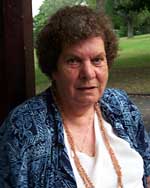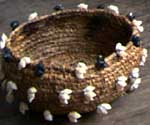I've lived near the sea most of my life. My dad was a fisherman. My husband was a fisherman and both my sons. Often I'd go out on the boat with my husband cray fishing and we'd be anchored off sheltered beaches for the night and we'd go ashore and collect shells.
Shell necklace maker Muriel Maynard

I was born on Cape Barren Island. It's only a small island, and very isolated it was when I was growing up in the 30s and 40s. My mother died when I was only three. There were six of us on the island and we were fostered out to our aunties and relations. The lady I was fostered out to, she was an auntie and she was one of our stringers, making the shell necklaces.
I started off by just going collecting the shells with her. In those days, when those old ladies strung the shells, that little bit of money they got it would have been about ten shillings or one pound they'd get for a string of shells with that they could buy something they needed.
We had no electricity on the island, only kerosene lamps. My auntie sat in the front room - we never called it the lounge room, it was always the front room - by the kerosene light, stringing her shells of a night. She had a cupboard that she kept her shells in but no-one could touch that. She used to let us watch her string.

They were secret, the women, in doing it. Noone saw each other's necklaces. They did them at home. They'd go in groups collecting shells but they'd never get in a group to string shells or anything like that.
We could go and collect the shells but they didn't show us how to make the shell necklaces. I think it's because the shells they got were so precious to them they wouldn't let the younger ones touch them.
To get the mareeners we wait for a spring tide and we have to walk into the water up to our waist or knees and pull the mareener shells off (the seaweed). It's the same as the little rice shells, they live in the dry seaweed. We fill our buckets up with seaweed then we go and wash the seaweed out and these shells fall in the bottom of the bucket. The toothies we have to pick up one at a time too. So it takes a long time to make one of these necklaces.
I love the beaches and I love picking up shells, sorting them out, washing and cleaning them. I can string and string and string. It takes about 3 or 4 days to make a necklace. And with these little ones, you've got to count them all that you put on. To get our patterns, we try to make them as even as we can.
I don't like to wear my necklaces so that they can be broken. Collector's items I reckon they are. I give them to friends and if someone I know asks me I'll make a necklace for them.
I have two daughters. One lives on Flinders lsland and she collects shells for me but the other one, she's not interested. She works at the hospital. She's more interested in computers!
In one way I suppose I am the custodian of knowledge about our culture. That means a lot to us. We remember when the older ladies used to string them and it's got a lot of memories for us. When we go back to Cape Barren I can imagine those old ladies over on those beaches, walking that far and taking whatever they had to eat, boiling the billy on the rocks and making the fire, cooking and eating shellfish. I never forget things like that. I feel like I'm the next generation carrying it on and I'm proud of that.
I've tried to hand the shell necklace making down to the younger ones and that's one thing I'd like to do, hand it down so the younger ones can keep it going.
Related
My favourite shell is the mareener (a greeny purple or blue shell with a mother-of-pearl finish when cleaned). In the majority of necklaces I make you'll always find a mareener shell. It's my favourite I suppose because it was my Mum and Dad's favourite shell.
I watched my mother making shell necklaces. She made them apparently before they were too many of us children. There were ten in my family. She made them in earlier times for pocket money helping to feed and clothe us kids. But then she gave it away for a few years, then she moved to Launceston.



